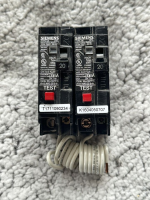synchro
Senior Member
- Location
- Chicago, IL
- Occupation
- EE
Does public safety personel with two way radios ever enter the buildings?
Thats an interesting question because just about all personnel here have hi band radios, its how we operate. Could that affect the breakers in some negative radio? thanks
The RF from the two way radios could get rectified by semiconductor junctions in the DF breaker, and this could conceivably cause it to trip. If you want, you might key up a 2-way radio near a 2-wire extension cord that's plugged into a receptacle to see if it would cause a DF breaker to trip.
You might try putting a ferrite toroid on the pair of hot and neutral output wires from the dual function breaker that 's tripping in the empty room.
The toroid at the first link below would introduce a common-mode impedance to reduce interference at High Band (i.e., around 150 MHz). The one at the second link would work better for lower frequency interference. You could try both.
If you have enough slack, have the hot & neutral pair make one loop around the toroid to increase the impedance. Otherwise, just pass the pair through the opening.



